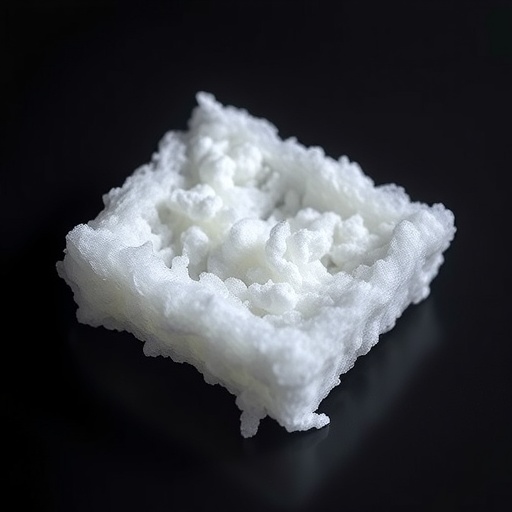In recent years, the alarming levels of heavy metal contamination in natural water bodies have attracted significant attention. Among these contaminants, lead stands out due to its severe toxicity and pervasive presence in the environment, primarily stemming from industrial discharges, mining activities, and urban runoff. The quest for effective, efficient, and sustainable methods to extract and remove lead from aqueous sources is more critical than ever. In this context, a groundbreaking study led by Fakhari et al. offers a promising solution through the electrochemical synthesis and regeneration of tannic acid-modified graphene oxide-Fe₃O₄ (AmGO-TA/Fe₃O₄), a novel nano-adsorbent designed specifically for lead remediation.
Graphene oxide, with its exceptional surface area and unique chemical properties, has emerged as a potent material in environmental applications. Its ability to interact with various molecules makes it an ideal candidate for adsorption purposes. The integration of iron oxide nanoparticles, specifically Fe₃O₄, further enhances the adsorbent’s effectiveness, providing magnetic properties that facilitate easy recovery after use. Utilizing a combination of these materials, the research team developed a hybrid adsorbent that maximizes lead removal efficiency while simultaneously allowing for its regeneration and reuse.
The electrochemical synthesis process employed by the researchers represents a leap forward in the fabrication of composite materials. This innovative method not only promotes the formation of the desired nanoparticles but also ensures their uniform distribution throughout the graphene oxide matrix. The application of electrochemical techniques allows for precise control over particle size and surface characteristics, which are critical parameters influencing adsorption capacity. This level of control can significantly enhance the adsorbent’s performance in filtering out lead ions from contaminated water.
One of the standout features of the AmGO-TA/Fe₃O₄ nano-adsorbent is its modification with tannic acid. Tannic acid, a naturally occurring polyphenolic compound, is known for its strong binding affinity to metal ions, which significantly aids in the removal process. By functionalizing the graphene oxide with tannic acid, the researchers created a material that enhances lead ion retention through both electrostatic and chemical interactions, making it particularly effective in aqueous environments where lead concentration may fluctuate.
The study emphasizes the importance of sustainability in the design of adsorbents for environmental cleanup. Conventional methods of lead removal often involve costly reagents and processes that generate secondary waste, contributing further to environmental degradation. In contrast, the electrochemical regeneration of AmGO-TA/Fe₃O₄ not only allows for the effective recovery of lead but also restores the adsorbent’s functionality. This regenerative capability means that the same amount of adsorbent can be used multiple times without significant loss of performance, thus reducing overall material consumption and waste output.
Experimental results presented in the study showcase the significant potential of the AmGO-TA/Fe₃O₄ nano-adsorbent. The removal efficiency for lead ions was found to exceed expectations, achieving high adsorption capacities within a short timeframe. The authors detail the mechanism of lead ion interaction, highlighting the roles played by both the physical properties of the adsorbent and the inherent characteristics of lead ions. This dual approach not only broadens the understanding of lead removal mechanisms but also sets the stage for optimizing adsorbent formulations for future applications.
In addition to laboratory testing, Fakhari et al. explored the operational feasibility of deploying this hybrid adsorbent in real-world settings. The potential for application in various water treatment facilities was discussed, alongside considerations for scalability and economic viability. By addressing these practical aspects, the research paves the way for translating laboratory successes into meaningful environmental action.
The implications of this research extend beyond lead removal. The methodologies and findings derived from the development of the AmGO-TA/Fe₃O₄ adsorbent can inform future studies aimed at addressing other environmental contaminants, such as cadmium, arsenic, and even organic pollutants. The adaptability of the synthesis and modification techniques means that similar approaches could be utilized to construct specific adsorbents tailored to target a diverse range of harmful substances.
As global water resources continue to face the threat of contamination, the demand for innovative, affordable, and sustainable remediation technologies will only grow. The findings presented by Fakhari et al. offer a strong case for the expanded use of nano-adsorbents in environmental cleanup efforts. Their success could serve as a catalyst for further research and development in this critical area, making strides toward cleaner and safer freshwater sources.
In summary, the electrochemical synthesis and regeneration of tannic acid-modified graphene oxide-Fe₃O₄ represent a convergence of advanced material science and environmental engineering, resulting in a powerful tool for lead remediation. The collaborative effort showcased in the study underlines the significance of interdisciplinary approaches in tackling complex environmental challenges. With increasing attention to sustainable practices, technologies like AmGO-TA/Fe₃O₄ may herald a new era in water treatment solutions.
As the research community continues to explore the full potential of nanomaterials in environmental applications, the promising results of this study provide a foundation upon which to build. The integration of eco-friendly materials, innovative synthesis methods, and a focus on reusability signals a positive direction for future advancements in the field.
In conclusion, the development of AmGO-TA/Fe₃O₄ not only aligns with global sustainability efforts but also represents a concrete step toward addressing one of the most pressing environmental issues of our time. The innovation encapsulated in this research underscores the importance of continued investment in scientific inquiry aimed at preserving the integrity of our natural resources.
Subject of Research: Lead removal from aqueous media using modified graphene oxide.
Article Title: Electrochemical synthesis and regeneration of tannic acid–modified graphene oxide-Fe₃O₄ (AmGO-TA/Fe₃O₄) as a recyclable and reusable nano-adsorbent for lead removal from aqueous media.
Article References:
Fakhari, N., Derakhshan, A.A., Rostami, A. et al. Electrochemical synthesis and regeneration of tannic acid–modified graphene oxide-Fe3O4 (AmGO-TA/Fe3O4) as a recyclable and reusable nano-adsorbent for lead removal from aqueous media.
Environ Sci Pollut Res (2025). https://doi.org/10.1007/s11356-025-37081-0
Image Credits: AI Generated
DOI: https://doi.org/10.1007/s11356-025-37081-0
Keywords: Lead removal, graphene oxide, tannic acid, nano-adsorbent, electrochemical synthesis, water treatment.




